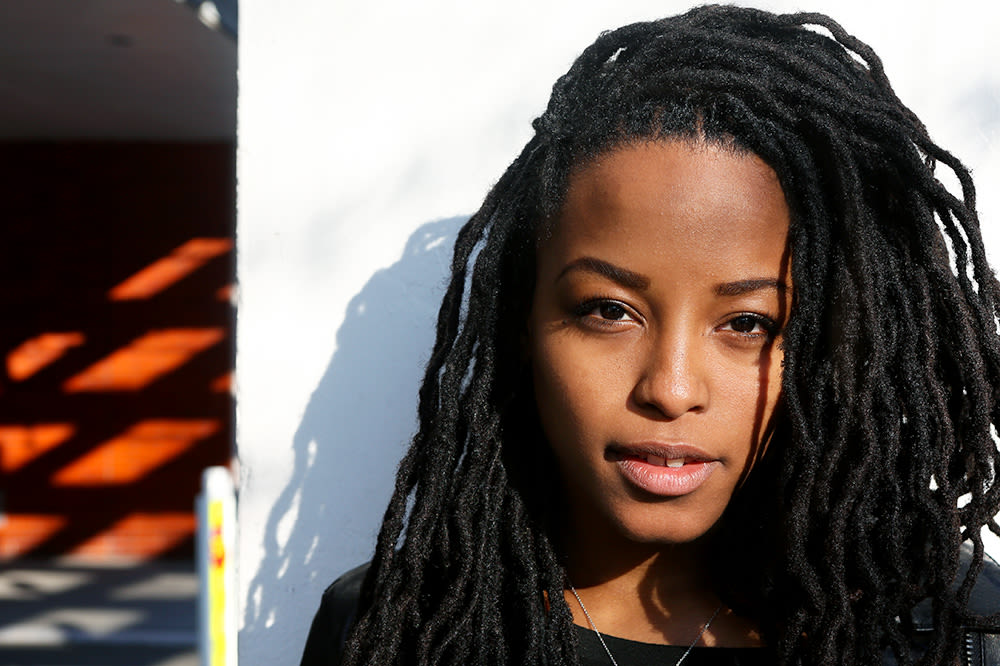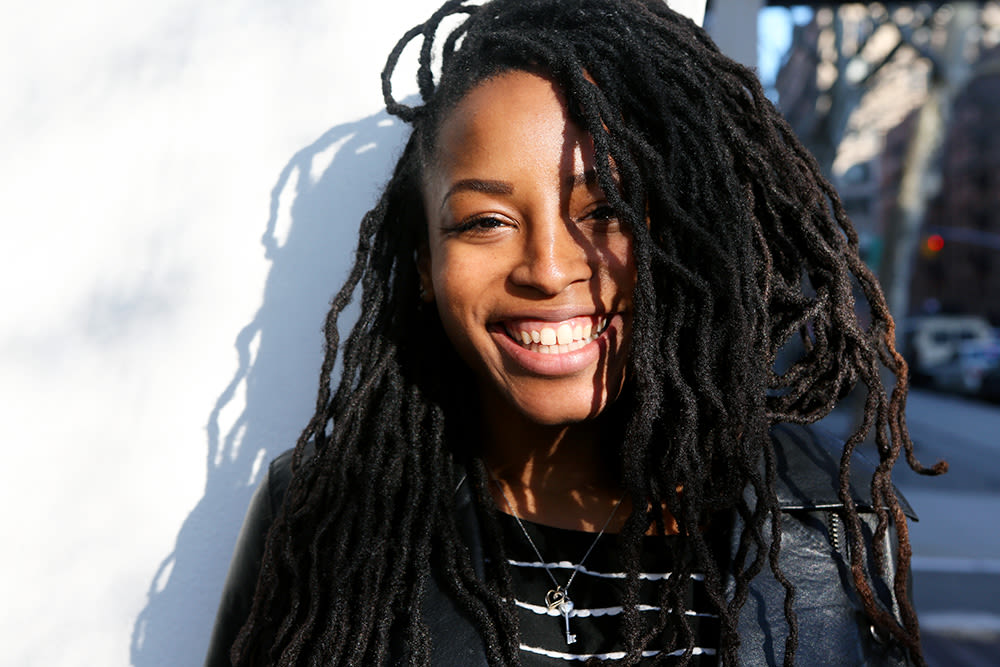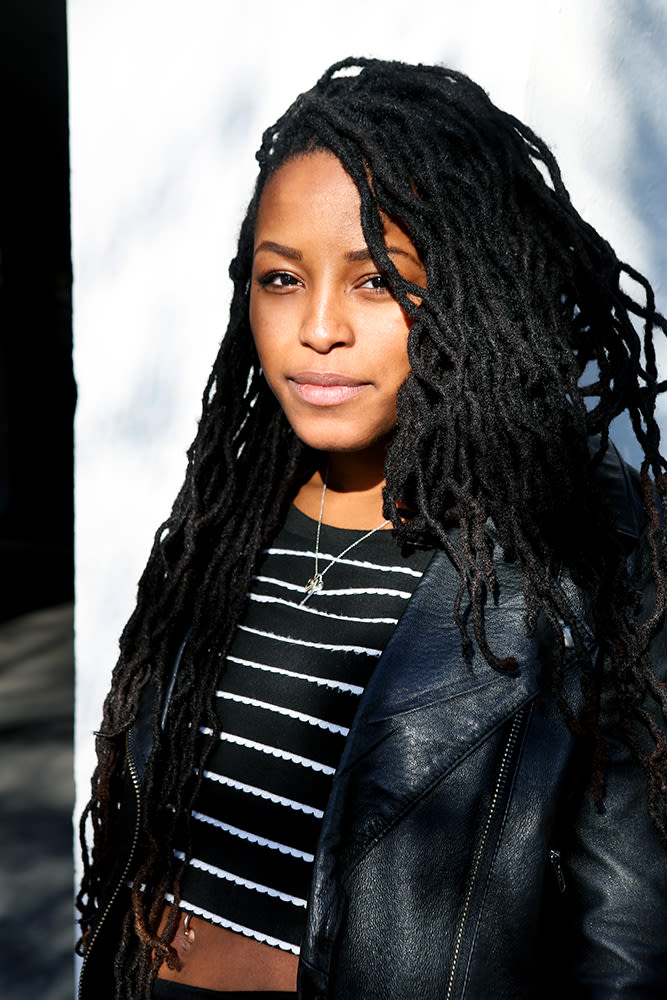The first time I'd seen locks (“dreadlocks,” but I prefer the abbreviated version as I don't find them dread ful) was on my aunt, my uncle, and my cousin, Jada. She was only three years old, but I remember how original and free she looked. At the time, I had no idea that my extended family would have such an impact on my little universe. And as much as I would like to say that as a grade schooler I had already formed some overarching idea about what hair meant to me on an emotional and spiritual level, I’m pretty sure that I simply didn’t want mine to be chemically straightened anymore. I hated what I called “the white stuff” and would rather do just about anything other than primp my hair every day. The relaxing process took an eternity in kid years: the white stuff is applied, then you just sit there for what feels like hours—bored and covered in goo—before it’s washed out. Next came the exhaustive blow-drying and curling. I guess it doesn’t take age to recognize life’s low dividends.
At 11 years old, I finally convinced my mom to let me lock my hair like my little cousin. In the era of pink streaks and butterfly clips, I had a different idea of what I wanted to look like, and what I wanted my hair to make me—or not make me—feel like. I had actually begged my mother for them two years prior, but she convinced me that a nice set of braids would be more appropriate and easier to change. That’s the thing about locks: they’re a commitment.
Finally sure that I knew what I wanted, my mom scheduled an appointment with our family hairdresser, Rosalyn. She told her I was done with relaxers and was moving toward embracing my hair’s natural state. Rosalyn's response?(“Okay, let's chop it off.” What seemed like the perfectly reasonable task of cutting off the chemically-straightened lengths turned into a rather traumatic experience. Nine inches of my hair were removed that day. I was emotional, to say the least. I think my exact words were,(“But it’s gone!' The next week, my uncle arrived at my house, sat me down on the floor, and began to form my hair into tiny two-strand twists with knots on the ends, all the while sharing his wisdom of what it meant to have natural hair. The knots were placed to keep the hair from unraveling, representing the finality of the decision. At the end of the session, I looked in the mirror to see a baby Coolio looking back.
At that point, I was only at the beginning of my natural hair journey. Since then I’ve been through four distinct phases, learning to either tough it out when it came to the awkward periods, or to get creative and find ways to mask the struggle that is growing out your locks. And I did this all while learning to navigate life as a teenager.
Phase 1: What on earth am I supposed to do with this?
The first six months are the toughest. Your main goal is to contain the hair and make it obey. In their beginning stages, short locks like mine tend to just stick up all over the place. If you’re not on summer break or sabbatical and you actually have to be seen in public, reach for headbands, scarves, hats, or anything else that will make your bold move look purposeful and not like you’re going through a “rough patch” in your life. Oh, and you’ll fall in love with your favorite earrings all over again.
Phase 2: This is still too damn short.
It’s been about one to three years. You pray that your hair grows faster so it doesn't look like the leaves of a strawberry sprouting out of your head because the layers from a previous hairstyle are now growing at unpredictable speeds and lengths. I went through this phase pretty hard. My hair was just too short for me to deal with, so my mom took me to a salon to have two-strand twist extensions attached over my locks to keep them tamed while they grew to a decent length. It worked for a while, until I realized I was contradicting my entire reason for wanting locks in the first place: to be natural, like my uncle taught me. I ditched the extensions, and my primary goal became about getting all of the locks into a ponytail holder—no matter how short the tail.
Phase 3: I’m over the strawberry head. It’s getting heavy, and I’m getting restless.
It’s been about five to seven years. You wonder if your hair is doing what locks are supposed to do. They’re quite lengthy, and you braid them and curl them whenever you can, but they have a mind of their own. You’re seriously starting to miss the weekly trips to the hairdresser and constant reinvention of yourself that comes from having almost any other hairstyle. You’re at a loss to come up with something that gets you excited about your hair again (there’s no denying that experimentation is fun, even if you’ve committed to locks), and you’re struggling to find a natural hairdresser you trust. The good thing is, this phase doesn’t last that long. My solution was color—I had it highlighted, which worked for my purposes, even if I did now slightly resemble T-Pain.
Phase 4: OK, I look good.
You’ve had your locks for about 10 or more years, and they’re probably over a foot long at this point—if you didn’t cut them. You feel knowledgeable about natural hair and you know the basic journey, so you’re more comfortable talking about your hair and your decision with others. That’s where I am now, as I write this. One of the most common questions I get is,(“Is that your real hair,” but I've already addressed that, so we'll go with another,(“How do you wash it,” The low-maintenance types will probably be interested in the fact that I only need to wash it every two weeks—usually with Dr. Bronner's, but sometimes I use the drugstore brand Cantu, which is more conditioning. The process takes about 30 minutes, because I wash it several times in one session. Then, while it's still wet I apply coconut oil, focusing on my scalp. After that, I twist each lock, rolling the hair closest to the root between my palms with Lock & Twist Gel, which incorporates the new growth into the existing lock. I then put it in 8-10 plaits and let it air dry, or if it's winter I'll sit under a dryer. When I take it down, it has some crinkle which gives it nice body. Sometimes I'll curl it—I just wrap each lock around a pipe cleaner and let it set overnight.
My locks have grown longer than I’d ever imagined—well past my behind—and it’s hard to imagine myself without them. It took 13 years of struggling with being the only teenager without a flat iron and tons of hair product and accessories, and instead with weird strings growing out of my head, but I'm better for it. My favorite confirmation of my decision to lock came from a poem by Kanita Poet called “Dreadlocks”:
Mother Nature has styled my hair with care and love untold.
I found her truest beauty when I let her take control.
With strong creative hands on my African head,
She locks my nappy hair until my strength becomes my dreads.
And now as my hair grows so long it thrills me when I see,
An image that's not put on, but one that's truly me.
My hair is now no problem, I can toss it in the wind.
My dreadlocks give me freedom, courageous strength within.
To some it seems extreme (ouch), it's a cultural shock.
To me it just my hair, and I love my locks.
To some, I think, the decision to lock seems extreme, but I’m proud of it. The number one most common question people always ask is,(“Will you ever cut them off and do something else to your hair,” My response is always, “Maybe!” Because what they might not realize is that with locks, thoughts about what to do to my hair are sort of taken out of the equation. I don’t constantly have to consider this type of thing—I don’t stress over finding the perfect inspiration photo to bring to my stylist, or saving up for a keratin treatment, or even what's apparently more exhausting: considering whether or not to get bangs. Throughout everything, I’ve realized that I am not my hair.
—Déjà Turner
Déjà is a recent graduate of Stephens College, and one of ITG's extraordinary interns. Keep up with her and her beautiful locks on Instagram @DejaTurner.






